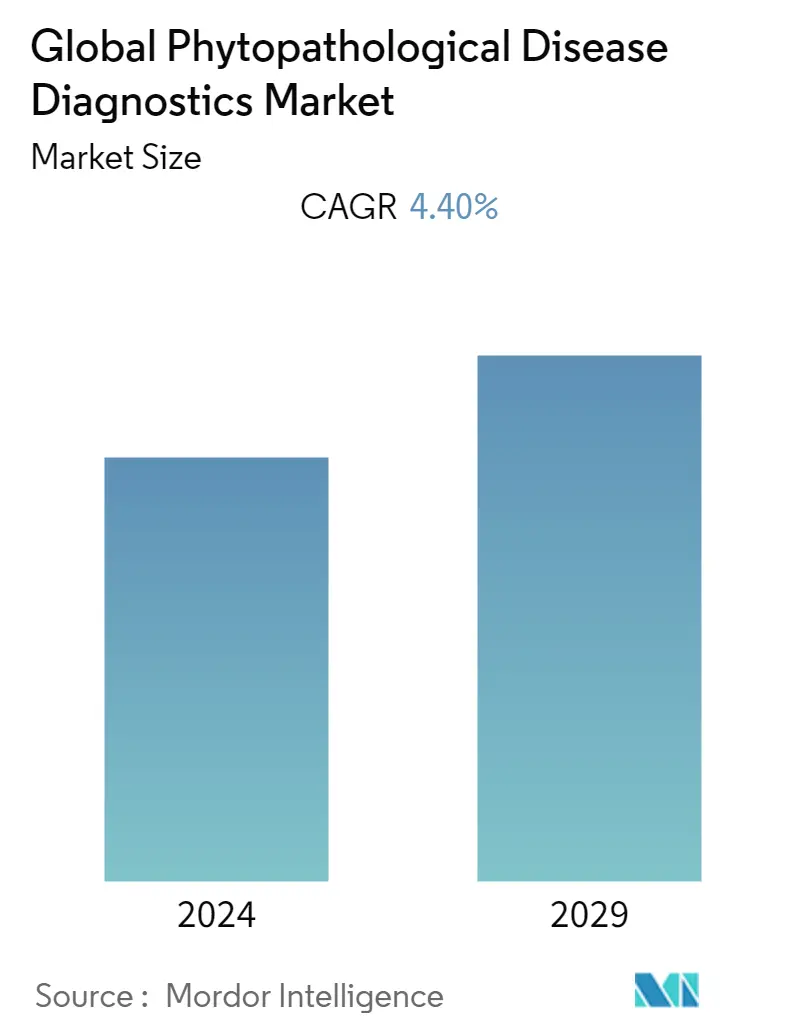Market Size of Global Phytopathological Disease Diagnostics Industry

| Study Period | 2019 - 2029 |
| Base Year For Estimation | 2023 |
| Forecast Data Period | 2024 - 2029 |
| CAGR | 4.40 % |
| Fastest Growing Market | Asia Pacific |
| Largest Market | North America |
Major Players
*Disclaimer: Major Players sorted in no particular order |
Need a report that reflects how COVID-19 has impacted this market and its growth?
Phytopathological Disease Diagnostics Market Analysis
The Phytopathological Disease Diagnostics Market is anticipated to grow with a CAGR of nearly 4.4% over the forecast period.
COVID-19 has impacted the crops and plants which has slowed down the market growth. The COVID-19 pandemic's lockdown and quarantine procedures have reduced the production and supply of plant protection products (PPP), which has a negative impact on crop protection actions globally. Also, the disruption in the flow of the plant protection products (PPP) either from local or international suppliers to the farm level, has already resulted in reduced plant yields. For instance, according to an article published in January 2021, titled 'Editorial: Impacts of COVID-19 on global plant health and crop protection and the effect on global food security and safety', it has been observed that the transportation cost of pesticides was doubled, and shipping was delayed in East Africa due to fewer flights to the region which resulted in the serious pests' outbreaks and high loss of the crops. Thus, COVID-19 has impacted the market growth. However, with the releasing restrictions on COVID-19 and resuming transportation and import-export facilities, the studied market is expected to grow over the forecast period.
Certain factors that are propelling the market growth are the increasing prevalence of phytopathological disease and the benefits of rapid and accurate diagnosis of phytopathological diseases.
The rising number of plant diseases is the key factor driving the market growth. The pathogens that cause the majority of plant diseases include bacteria, viruses, and fungi. Plant diseases not only hinder plant growth but also lead to a reduction in plant yield. In addition to people and goods (including plant materials), a large number of harmful species, such as viruses, phytoplasmas, bacteria, fungi, insects, nematodes, and weeds, travel undisturbed. These species spread widely throughout the world and pose serious challenges to agriculture. Thus, early detection of plant pathogens is becoming increasingly important in plant health monitoring to manage disease infections at various stages of development, reduce the risk of disease dissemination, and avoid the introduction of new ones.
Additionally, the utilization of numerous test assay types to comprehend plant diseases has also created new opportunities for market expansion. Also, the development of various low-cost and easy-to-use technologies such as sensor platforms enable a label-free detection of the target pathogens with high sensitivity and specificity, overcoming the limitations of conventional diagnostic procedures. For instance, as per an article published in July 2022, titled 'Tobacco Mosaic Virus Infection of Chrysanthemums in Thailand: Development of Colorimetric Reverse-Transcription Loop-Mediated Isothermal Amplification (RT-LAMP) Technique for Sensitive and Rapid Detection', a colorimetric RT loop-mediated isothermal amplification (LAMP) technique was developed to enhance the speed and sensitivity of tobacco mosaic virus (TMV) detection in chrysanthemum in Thailand. It has been observed that the LAMP technique was 1000-fold more sensitive than RT-PCR and no cross-reactivity with other viruses or viroids was detected. This is expected to increase the adoption of RT-LAMP techniques in detecting various plant diseases due to their speed, accuracy, sensitivity, and specificity, thereby bolstering the market growth.
Also, according to an article published in March 2021, titled 'Advances in Plant Disease Detection and Monitoring: From Traditional Assays to In-Field Diagnostics', it has been observed that between 20% and 40% of the world's annual crop production is lost to pests, that also affect the major food crops (rice, wheat, corn, potatoes, soy, and cotton) at the national and regional levels throughout the various continents.
Furthermore, various rules have been issued to prevent the spread of pests in plants and to stem potential outbreaks. For instance, to conserve forests and landscapes, the Regulation (EU) 2016/2031 reduces the need for pesticides, simplifies documentation for farmers and producers, and provides financial support for surveillance, eradication, and containment. Such regulations are expected to support the producers by providing solutions that help in protecting plant diseases, thereby propelling the market growth.
However, the lack of skilled personnel and limited knowledge about plant health is expected to impede the market growth over the forecast period.
